What’s on Your Roof in Arizona?
 29 May 2018
29 May 2018 
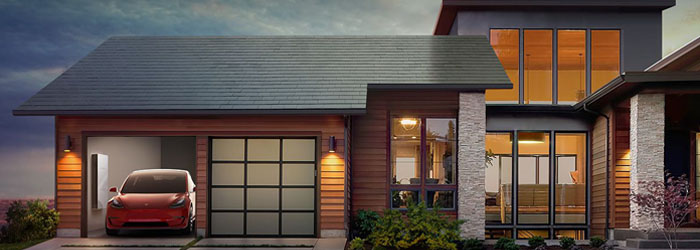
Six popular choices of roof including what they can do plus new roofing ideas
After living in Arizona for a while, you find out that only about a dozen types of roofing are frequently used in our state.
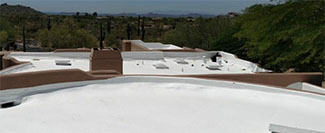
But the marketplace is changing and some new possibilities are on the horizon. If you're thinking about installing a new roof, you might be interested in the all the possibilities as well as pros and cons for each:
1 | Foam:
Foam is growing as the best solution for most flat roofs on Arizona homes. It's easy to work with and covers a roof completely with no seams or joints to split open and cause leaks. It's usually white which will reflect the sun. "The important thing about the foam is the insulation it provides," says Tim Forstie of Durafoam in Phoenix. "It's R-6.5, while the old tar and gravel is rated R-1."
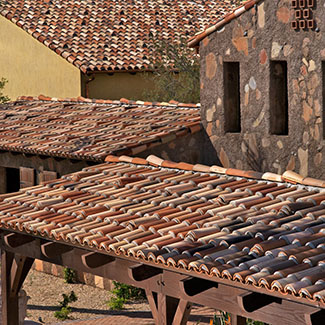
Foam will cost more than repairing a built-up roof which is the old way of covering flat roofs (described below). A foam roof can be long-lasting, but every five years you need a special separate elastomeric recoating done on holes and cracks, according to Forstie: "If you don't keep up recoating, the sun will eventually destroy your roof and it will leak."
2 | Built-up or modified bitumen roofs:
Many older homes with flat roofs still have built-up roofing. This less costly covering uses membrane sheets with seals that have seams between the sheets and around vents and pipes sticking out of the roof. These sheets are rolled asphalt that has heat applied so it will stick to the roof.
3 | Shingles, mainly asphalt or fiberglass:
Both types of shingles have an asphalt exterior. But fiberglass shingles have a fiberglass base, while asphalt shingles have an organic base, made of paper or wood. Fiberglass shingles have a higher fire rating and are thinner and lighter in weight. Asphalt shingles are more durable and rugged and more economical, too. Fiberglass is generally used in warmer climates. Both types of shingles are very long lasting.
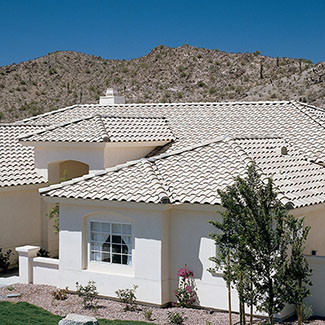
4 | Clay tiles and concrete tiles:
Tiles are very popular materials in Arizona because they enhance the Southwestern look of our homes.
Clay tiles include sandcast, two-piece, interlocking and flat - each with advantages and disadvantages. For example, sandcast is the matte-finished, rustic-looking tile popular for its European look, but can deteriorate in Arizona's intense sunlight.
Concrete tiles have grown popular because they are long-lasting and seem almost indestructible. You'll see them used on new subdivisions throughout Arizona. Both clay and concrete resist rot and insects.
What homeowners may not know that those tiles on the roof are actually not the "real" roof. What really protects houses from the elements is the underlayment beneath the tiles. Many roofers recommend an underlayment of two layers of 40-pound felt. Another high quality choice is G-40, a rolled bitumen material for the entire roof. Incidentally, many subdivision builders only use one layer of 30-pound felt.
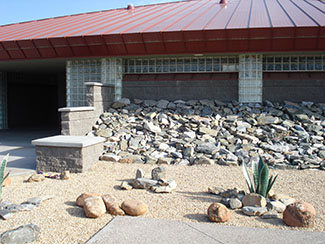
If you have a leaky tile roof, you probably need to replace that underlayment before you replace the tiles. If your tiles are in good shape, your contractor will remove them and put them back after the underlayment is replaced. If some tiles are broken you may have to replace them.
5 | Metal:
Metal roofing will greatly outlast asphalt shingles or concrete or clay tiles. It is low in weight and reflects the sun, making a home more energy-efficient. Metal is also fire-resistant. One problem with metal is its price. Although its appeal has grown, many homeowners think that sheets of metal on a roof may only look right on homes with a more modern look. But there are also metal tiles and shingles that look like they're made of clay or slate and could be used with traditional architecture. Metal is the Cadillac of roofing and can be made of aluminum, copper, stainless steel and zinc.
6 | Synthetics:
These are newer roofing products, including rubber, plastic and polymer roofing that look as if they're made of slate or wood. They're considered strong, long-lasting and less costly – especially compared to the natural products that they "imitate." Make sure you read the warranty carefully on newer products. Check out homes in your area where they have been used.
New Wild Ideas for Roofing Your House
Here are other new roofing concepts that might still need some work, but experts and dreamers are out there working on them:
Solar tiles:
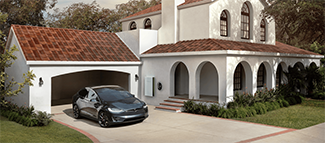 Instead of putting solar panels on your roof, one of these days, you might be installing "building integrated photovoltaics" – solar cells combined with different kinds of tiles or shingles on your roof. Electricity is generated when the sun strikes a semiconductor layer of silicon on the surface of shingles.
Instead of putting solar panels on your roof, one of these days, you might be installing "building integrated photovoltaics" – solar cells combined with different kinds of tiles or shingles on your roof. Electricity is generated when the sun strikes a semiconductor layer of silicon on the surface of shingles.
The price will probably be steep. Consumer Reports did a study indicating that in order to compete with the cost of installing a conventional asphalt roof, the cost of a 3,000 square-foot solar tile roof should not be more than $73,500.
That estimate was based on the idea that a homeowner could get 30 years of electricity out of the roof. Tesla, already promoting these photovoltaic roofing tiles, has estimated the cost at $65,550 for covering the same size house with solar tiles. Both calculations include the cost of Tesla's Powerwall battery that would be installed as well.
"Green" roofs:
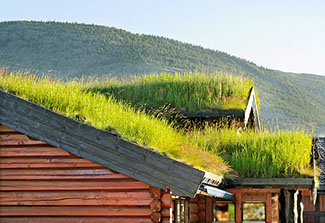 This concept discussed widely on the Internet is basically all about spreading soil or some other growing medium on your roof and then growing lots of green plants on top. There are homes around the country that have been built this way, but Arizona seems like an unlikely location since it's pretty hard here to keep green plants going in our yards at ground level.
This concept discussed widely on the Internet is basically all about spreading soil or some other growing medium on your roof and then growing lots of green plants on top. There are homes around the country that have been built this way, but Arizona seems like an unlikely location since it's pretty hard here to keep green plants going in our yards at ground level.
A "green" roof system may also cost lots of "green". It requires structural support, a vapor control barrier, thermal insulation, an irrigation system, waterproofing and drainage besides soil and the plants. However, there are some rooftop gardens in downtown Phoenix, so who knows what the future may hold?
###
Photo Credits:
RELATED CONTENT:
- Blog: 25 Tips And Tricks To Extend The Life Of Your Roof | Lyons Roofing
- Blog: How Can I Prevent Monsoon Storms From Damaging My Flat Roof And Causing My Ceiling To Leak?
- DIY FAQ: Can Fixing A Small Leak In My Roof Get Me Through Monsoon Season?
- Podcast: Controlling Bugs During the Monsoon
Print this page
recent post
- Duck, Duck, Duct! How Often Should Ductwork Be Cleaned?
- Vinyl vs. Fiberglass Windows: Which Is The Better Choice Of Replacement Window?
- We May Be The Grand Canyon State, But The Rocky Mountains Are Important For Arizona
- Welcome to Arizona! Things A Newbie to Arizona Should Know
- The Pros & Cons of Buying A Flipped House
- Getting In On The Ground Floor
- Why It’s More Critical Than Ever To Get Your AC Serviced Before Summer
- The Reality of Remodeling
- What To Look For When Comparing Your Roofing Quotes
- What To Expect When Buying New Windows & Doors
